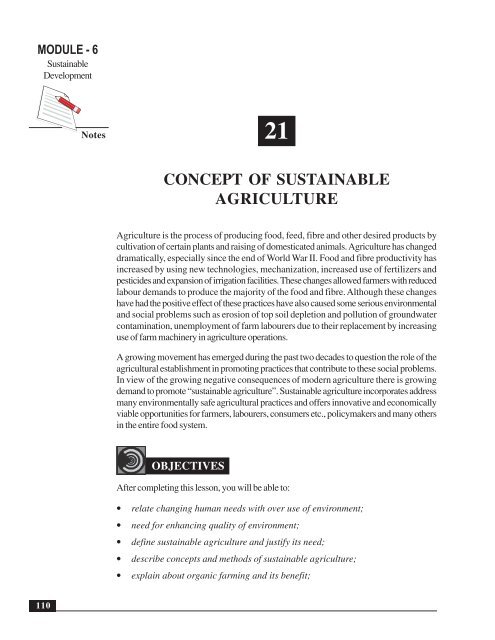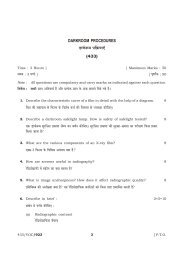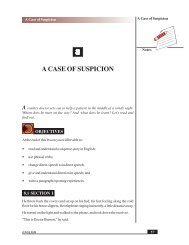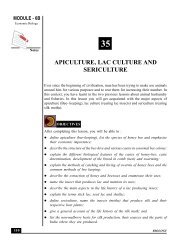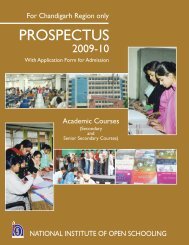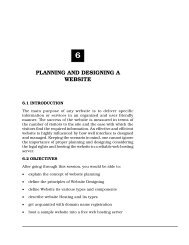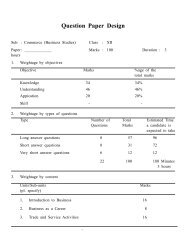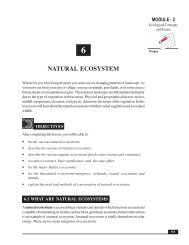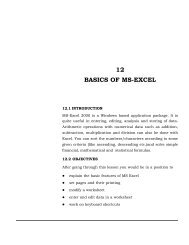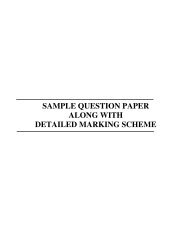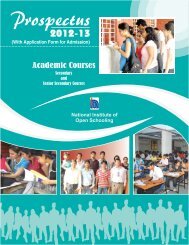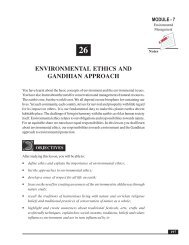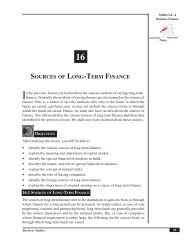Concept of Sustainable Agriculture
Concept of Sustainable Agriculture
Concept of Sustainable Agriculture
Create successful ePaper yourself
Turn your PDF publications into a flip-book with our unique Google optimized e-Paper software.
MODULE - 6<strong>Sustainable</strong>DevelopmentNotesEnvironmental Science Senior Secondary CourseThus, sustainable agriculture is one that,• supports pr<strong>of</strong>itable production;• protects environmental quality;• uses natural resources efficiently;• provides consumers with affordable, high-quality products;• decreases dependency on non-renewable resources;• enhances the quality <strong>of</strong> life for farmers and rural communities;• and will last for generations to come.INTEXT QUESTIONS 21.11. Define sustainable agriculture.______________________________________________________________2. Mention three advantages <strong>of</strong> sustainable agriculture.______________________________________________________________21.4 METHODS OF SUSTAINABLE AGRICULTURE<strong>Sustainable</strong> production practices involve a variety <strong>of</strong> approaches. At the planning level onemust take into account the local geography (topography), soil condition and nature, localclimate, pests, local inputs and the farmer’s goals. The grower (farmer) must then selectappropriate practices. Several methods adopted in sustainable agriculture are:• cultivation practices to increase biological and economic stability.• selection <strong>of</strong> improved varieties to suit the need.• soil management by proper method <strong>of</strong> tillage.Many farmers in India and other developing countries follow the traditional practice <strong>of</strong>mixed cropping or diverse cropping and crop rotation.(a) Mixed cropping or diverse croppingIt is an old practice in our country. Two or more crops are grown all at the same time in afield. If by chance one crop fails, the others crops cover the risk <strong>of</strong> total crop failure.Usually a long duration crop is grown with a short duration one so that both get sufficientnutrition at the time <strong>of</strong> maturity. Then water and nutrient requirement are also different.112
<strong>Concept</strong> <strong>of</strong> <strong>Sustainable</strong> <strong>Agriculture</strong>Generally a leguminous crop is grown alongwith the main crop. Legumes helps to increasesoil fertility by fixing atmospheric nitrogen. This saving the cost <strong>of</strong> chemical fertilizers.The various plans followed in diverse or mixed cropping practices are-• polyvarietal cultivation where several genetic varieties <strong>of</strong> the same crop are planted.• intercropping where two or more different crops are grown at the same time on a plotlike carbohydrate rich cereal that uses soil nitrogen and nitrogen fixing legume that putsback the nitrogen in the soil.• polyculture, in which different plants maturing at various times are planted together.This practice has many advantages because fertilizer and water requirement <strong>of</strong> plantsare different so there is less need <strong>of</strong> these inputs. Pests are controlled naturally becausetheir natural predators find multiple habitats to survive. It has been found that thispractice produces much higher yield per hectare compared to monoculture.MODULE - 6<strong>Sustainable</strong>DevelopmentNotesLarge scale mechanization lead to the spread <strong>of</strong> monoculture i.e. only one crop varietyis sown in the entire area when only one cultivator is planted in a large area. This systemuses lot <strong>of</strong> fertilizer, pesticide, water. This practice may be productive for sometime butcauses environmental and economic problems.(b) Crop rotationIt is practice <strong>of</strong> growing different crops in regular succession in the same field. This practicecontrols insects and diseases, increases soil fertility and decreases soil erosion. Generallysoil cannot sustain continuous cropping with high yielding single crop because certain nutrientsrequired by the crop get exhausted totally while others remain unutilized leading to seriousnutrients imbalance in soil and encouraging certain diseases and pests. Sowing a leguminouscrops (eg. green gram) as a rotational crop is very useful because legumes enhance nitrogenlevel in the soil due to their ability to fix atmospheric nitrogen, reduces the need for chemicalnitrogen fertilizer. Thereby cutting the cost and saving the soil from the harmful effects <strong>of</strong>using high yielding varieties alongwith the application <strong>of</strong> large amount <strong>of</strong> fertilizer, pesticidesand water. It is possible to grow two or sometimes three different crops in succession onthe same land within a year is known as multiple cropping. This practice can go on forsometime but the land cannot maintain high yield in the long run.Crop rotation takes into amount the following factors:(i) Leguminous crop should be grown after non-leguminous crop.(ii) Crops require less water (irrigation) should be grown after one – that requires morewater.(iii) Crops requiring less manure should be sown after one that requires more manure.113
MODULE - 6<strong>Sustainable</strong>DevelopmentNotesImportant crop patterns <strong>of</strong> crop rotation1. Green gram - Wheat – Moong2. Ground nut – Wheat – Moong3. Arhar – Sugarcane – Wheat – Moong4. Paddy – Wheat – MoongEnvironmental Science Senior Secondary CourseOptimum diversity may be obtained by integrating both crops and livestock in the samefarming operation. Mixed crop alongwith livestock operations have several advantages.First, growing crops only on more level land and pastures or forages on steeper slopes willreduce soil erosion. Second, pasture and leguminous forage crops in rotation enhance soilquality and reduce erosion; livestock manure, in turn, contributes to soil fertility. Third,livestock can buffer the negative impacts <strong>of</strong> low rainfall periods by consuming crop residuethat in “plant only” systems would have been considered crop failures. Finally, feeding andmarketing are flexible in animal production systems. This can help cushion farmers againstprice fluctuations and, make more efficient use <strong>of</strong> farm labour.Soil Management: A healthy soil is a key component <strong>of</strong> sustainable agriculture. That ishealthy soil along with water and nutrients produces healthy crop plants that are lesssusceptible to pests and diseases. Accordingly, soil must be protected and nurtured toensure long term productivity and stability. Methods <strong>of</strong> protection include using covercrops, compost, reducing tillage, conserving soil moisture by dead mulches, this increaseswater hold capacity <strong>of</strong> the soil.Varietal improvement with limited land at our disposal, we have to increase production <strong>of</strong>food grains, fodder, sugar, oil, fibers, fruits and vegetables. One <strong>of</strong> the most importantmethod to do that is to improve the existing varieties <strong>of</strong> plants by the application <strong>of</strong> geneticsand plant breeding and related sciences. Significant improvement in crop production hasbeen achieved by using the conventional methods <strong>of</strong> selection and plant breeding.Some <strong>of</strong> the objectives <strong>of</strong> varietal improvement are:(i) development <strong>of</strong> high yielding varieties <strong>of</strong> crop plants.(ii) food crops developed for better and higher nutritional quality like protein quality inpulses, baking quality in wheat, preserving quality in fruits and vegetables, oil quality inoil seed producing plants.(iii) development <strong>of</strong> crop varieties resistance to diseases and pests.(iv) improving varieties for resistance against heat, cold, frost, draught and water logging.21.5 BIO-FERTILIZERS AND THEIR USE IN AGRICULTUREFor a sustainable agriculture system, it is essential to use renewable inputs (fertilizer,pesticides, water etc.) which can benefit the plant and cause no or minimal damage to theenvironment. One possible way is to reduce the use <strong>of</strong> chemical fertilizers and pesticides.114
<strong>Concept</strong> <strong>of</strong> <strong>Sustainable</strong> <strong>Agriculture</strong>One <strong>of</strong> the energy efficient and pollution free method is to exploit the ability <strong>of</strong> certainmicroorganisms like bacteria, algae and fungi to fix atmospheric nitrogen, solubilizephosphorus, decompose organic material or oxidize sulphur in the soil. When they areapplied in the soil, they enhance growth and yield <strong>of</strong> crops, improve soil fertility and reducespollution. They are known as “bio fertilizers”. Thus bio-fertilizers are living or biologicallyactive products or microbial inoculants <strong>of</strong> bacteria, algae and fungi (separately or incombination) which are able to enrich the soil with nitrogen, phosphorus, organic matteretc.MODULE - 6<strong>Sustainable</strong>DevelopmentNotes21.5.1 Important bio fertilizersFollowing are some <strong>of</strong> the important types <strong>of</strong> bio fertilizers which can be considered foragro based industries.• Rhizobium bi<strong>of</strong>ertilizer: Rhizobium is a symbiotic bacteria forming root nodules inlegume plants. These nodules act as miniature nitrogen production factories in thefields. The nodule bacteria fix more nitrogen (N 2) than needed by legume plant and thebacteria. The surplus fixed nitrogen is then secreted and fertilizes the soil. Rhizobium ismore efficient than-free living nitrogen-fixing bacteria and can fix upto 200 kg N/ha/yr.• Azotobacter bi<strong>of</strong>ertilizer: Azobacter are aerobic free living nitrogen fixers. Theygrow in the rhizosphere (around the roots) and fix atmospheric nitrogen nonsymbioticallyand make it available to the particular cereals. These bacteria producegrowth promoting hormones which helps in enhancing growth and yield <strong>of</strong> the plant.• Azospirillium bi<strong>of</strong>ertilizer: These are aerobic free living nitrogen fixers which live inassociative symbiosis. In this type <strong>of</strong> association bacteria live on the root surface <strong>of</strong> thehost plant and do not form any nodule with roots <strong>of</strong> grasses. It increases crop yieldand its inoculation benefits crop. They also benefit the host plants by supplying growthhormones and vitamins. These bacteria are commonly used for the preparation <strong>of</strong>commercial inoculants.• Blue green algae: Blue green algae (BGA or cyanobacteria) like Nostoc andAnabaena are free living phostosynthetic organisms also capable <strong>of</strong> fixing atmosphericnitrogen. In the flooded rice fields blue green algae serves as a nitrogen bi<strong>of</strong>ertilizer.• Azolla bi<strong>of</strong>ertilizers: Azolla is a water fern inside which grows the nitrogen fixingblue green algae Anabaena. It contains 2-3% nitrogen when wet and also producesorganic matter in the soil. The Azolla-Anabaena combination type bi<strong>of</strong>ertilizer is usedall over the world. This can be grown in a cooler regions. But there is a need todevelop a strain that can tolerant to high temperature, salinity and resistant to pestsand diseases. Production technology is very easy and can be adopted by rice farmers.The only constraint in Azolla is that it is an aquatic plant and water becomes limitingfactor in growing it particularly in summer.• Phosphorus solubilising bi<strong>of</strong>ertilizer: Phosphorus is an important element requiredfor plant growth. This element is also needed for nodulation by rhizobium. Some115
MODULE - 6<strong>Sustainable</strong>DevelopmentNotesEnvironmental Science Senior Secondary Coursemicroorganisms are capable <strong>of</strong> solubilizing immobilized phosphorus making it availableto plants for absorption.• Mycorrhizal fungi acts as bi<strong>of</strong>ertilizer are known to occur naturally on roots <strong>of</strong> foresttrees and crop plants. In soils low in available nutrients there is an increased absorption<strong>of</strong> nutrients by plants infected with Mycorrhiza. The fungus has the ability to dissolveand absorb phosphorus that plant roots can not readily absorb.A wise way will be to develop an integrated nutrient supply system involving the combination<strong>of</strong> chemical fertilizers and bi<strong>of</strong>ertilizers.INTEXT QUESTIONS 21.21. How does crop rotation practice improve soil quality?______________________________________________________________2. What is the difference between polyculture and multiple cropping?______________________________________________________________3. Define bi<strong>of</strong>ertilizers and give two important advantages <strong>of</strong> using it.______________________________________________________________4. What roles do Rhizobium and blue green algae play in agriculture?______________________________________________________________21.6 ORGANIC FARMING AND ITS BENEFITSOrganic farming is a type <strong>of</strong> agriculture or farming which avoids the use <strong>of</strong> synthetic fertilizers,pesticides, growth regulators, and livestock feed additives. Organic farming systems relyon crop rotation, crop residues, animal manures, legumes, green manure, <strong>of</strong>f-farm organicwastes and bi<strong>of</strong>ertilizers, mechanical cultivation, mineral bearing rocks. To maintain soilproductivity to supply plant nutrients and biological pest control, controlling weeds, insectsand other pests. All kinds <strong>of</strong> agricultural products can be produced organically, includinggrains, meat, dairy, eggs, fibres such as cotton, jute, flowers etc. Thus organic farmingcreates a sustainable lifestyle for generations to come.Organic farmers build healthy soils by nourishing the living component <strong>of</strong> the soil, themicrobial inhabitants that release, transform, and transfer nutrients. Soil organic mattercontributes to good soil structure and water-holding capacity. Organic farmers feed soilbiota and build soil organic matter with cover crops, compost, and biologically based soilamendments. These produce healthy plants that are better able to resist disease and insectpredation. Organic farmers’ primary strategy in controlling pests and diseases is preventionthrough good plant nutrition and management. Organic farmers use cover crops andsophisticated crop rotations to change the field ecology, effectively disrupting habitat for116
<strong>Concept</strong> <strong>of</strong> <strong>Sustainable</strong> <strong>Agriculture</strong>weeds, insects, and disease organisms. Weeds are controlled through crop rotation,mechanical tillage, and hand-weeding, as well as through cover crops, mulches, flameweeding, and other management methods. Organic farmers rely on a diverse population <strong>of</strong>soil organisms, beneficial insects, and birds to keep pests in check. When pest populationsget out <strong>of</strong> balance, growers implement a variety <strong>of</strong> strategies such as the use <strong>of</strong> insectpredators, mating disruption, traps and barriers.MODULE - 6<strong>Sustainable</strong>DevelopmentNotesSome important benefits for organic farming and organic foods:• Organic farming is a science in itself which can be learnt easily by any conventionalfarmer.• It has been found that by switching to organic farming, conventional farmer can actuallyreduce its production cost by over 25% as compared to the cost <strong>of</strong> conventionalfarming. This is eliminate the use <strong>of</strong> expensive synthetic fertilizers and pesticides,minimizing soil erosion by up to 50% and increasing crop yields up to five-folds.• A well planned transition strategy may allow conventional farmers to adopt new, moreeffective organic farming practices easily.• Organic farms can support substantially higher levels <strong>of</strong> wildlife especially in low landsand where animals can roam in pastures or graze on grassland. Not only does wildlifebenefit, but entire ecosystems and ground water are improved by simply followingorganic farming methods.• Organic farming practices not only benefit farmers and consumers; but the dairies canbenefit. When dairies feed their cows organic feed and graze them on organic fields,the cows experience better health, less sickness, diseases and ultimately produce bettertasting milk for consumers.• Organic farming promotes healthy soils that are teaming with life and rich in micronutrients and which can be used for decades to grow crops without getting exhausted.• Consumers purchasing organically grown foods are tastier. Regardless <strong>of</strong> minimal pricedifferences, consumers can smell, taste and see the difference in the quality <strong>of</strong> organicallygrown food products.• Organically grown products are free from harmful chemicals, artificial flavors andpreservatives that ultimately cost consumers more money than non-organically grownproducts. You can always taste the difference between organically grown andconventionally grown products.21.7 VERMICOMPOSTVermicomposting is an appropriate technique for efficient recycling <strong>of</strong> animal wastes, cropresidues and agro-industrial wastes. The process <strong>of</strong> conversion <strong>of</strong> organic materials intomanure is chiefly microbiological. Earthworms are important for producing vermicompostfrom organic wastes.117
MODULE - 6<strong>Sustainable</strong>DevelopmentNotesEnvironmental Science Senior Secondary CourseVermicompost can be prepared from all sorts <strong>of</strong> organic residues. Examples:• Agricultural residues- dry organic wastes (like sorghum straw, rice straw after feeding cattle, dry leaves,pigeon pea residues, groundnut husk and wheat husk)- waste vegetables- soybean residues- weeds (particularly Parthenium hysterophorus, also called Vayyaribhama orPander full or Congress weed, before flowering)- sugarcane trash• Sericultural residues from silk production• Animal manures• Dairy and poultry wastes• Food industry wastes• Municipal solid wastes• Biogas sludge• Bagasse from sugarcane factories21.7.1 Steps in Making VermicompostStep 1:Step 2:Step 3:Step 4:Step 5:Step 6:Step 7:Step 8:Step 9:Step 10:Step 11:Step 12:Step 13:Cover the bottom <strong>of</strong> the cement ring with a polythene sheet. (Or use the sheet tocover the ground <strong>of</strong> the area you’re using).Spread a layer (15-20 cm) <strong>of</strong> organic waste on top <strong>of</strong> the sheet.Sprinkle rock phosphate on top <strong>of</strong> the organic material (2kg).Prepare cow dung slurry (15kg) and add the slurry as a layer on top <strong>of</strong> the mixture.Fill the ring completely and evenly with the layered material.Paste cow dung or soil over the top <strong>of</strong> the material.Allow the material to decompose for 20 days. After 20 days, put the earthworms ontop. They will find the cracks and enter the material.Cover the ring with wire mesh or gunny bags to prevent birds from eating the worms.Sprinkle water over the whole mixture at 3-day intervals for 2 months, to maintainadequate moisture and body temperature <strong>of</strong> the worms. Note: when the compost isready, it is black, quite lightweight and has a pleasant, earthy smell.After 2 months, (or when the compost is ready), remove the ring and heap the materialin a cone shape on the floor. Leave the heap undisturbed for 2-3 hours, to let theworms move slowly to the bottom.Separate the upper portion <strong>of</strong> the heap.Sieve the lower portion <strong>of</strong> the heap to separate the worms. They can be used again forpreparation <strong>of</strong> more vermicompost.Pack the compost in bags and store them in a cool place.118
<strong>Concept</strong> <strong>of</strong> <strong>Sustainable</strong> <strong>Agriculture</strong>21.8 INTEGRATED PEST MANAGEMENT (IPM)The most sustainable way to control pests is a carefully designed integrated pest management(IPM) program. In this approach, each crop and its pests are evaluated as parts <strong>of</strong> anecological system. Then farmers develop a control programe that includes cultivation,biological and chemical methods applied in proper sequence and with the proper timing.MODULE - 6<strong>Sustainable</strong>DevelopmentNotesThe aim <strong>of</strong> IPM is not to eradicate the pest population completely but to keep the cropdamage to economically tolerable level.Farmers monitor the field and when they find the pest level to be high enough, they first usebiological methods and cultivation practices to control and then use small amounts <strong>of</strong>insecticides mostly insecticides derived from plants as a last resort.(a) Biological control includesNatural predators, parasites and pathogens <strong>of</strong> the pests are used. Examples are:• Pest on cucumber plant called red spider mite is controlled by using a predatory mitethat feed on red spider mite.• Citrus fruits in California heavily damaged by scale insects which were controlled byAustralian ladybird which ate away the insects.• Mealy bug pest <strong>of</strong> Cassava plant were controlled by a parasitoid wasp which was itsnatural enemy.• Hormones are used that disrupt the insects normal life cycle, thereby preventing itfrom reaching maturity and reproducing and multiplying.(b) Cultivation practicesA variety <strong>of</strong> cultivation practices like crop rotation, polyculture and inter cropping etc. canbe used to get rid <strong>of</strong> the pests. This has been discussed in details earlier in this lesson.(c) Some amounts <strong>of</strong> insecticides, mostly <strong>of</strong> plant origin (e.g. Pyrethrum and Rotenoneneem product) are applied as a last resort.(d) Pest and disease resistant crop plants can be produced by genetic engineering. Exampleis Bt cotton, insecticidal for bacterial gene (Bacilus thuringinesis) introduced into cottonplant making cotton plant resistant to pest.Like any other form <strong>of</strong> pest control method has some disadvantages:• Farmer should have an expert knowledge about each pest.119
MODULE - 6<strong>Sustainable</strong>DevelopmentNotes• It acts more slowly than conventional pesticides.Environmental Science Senior Secondary Course• Methods developed for a crop in one area might not apply to areas with even slightestdifferent growing conditions.• Initial cost may be higher but in the long-term cost become very low.21.9 BIOTECHNOLOGY AND MODERN AGRICULTUREWith conventional breeding practices reached their saturation point, the “gene revolution”seems to hold lot <strong>of</strong> potential. Agricultural biotechnology or gene technology or geneticengineering may act as the second “green revolution” that can be used to create highyieldingcrop varieties that are: (i) herbicide tolerant, (ii) insect resistant, (iii) resistant topathogens like virus, bacteria and fungi (iv) have better nutritional value and other commercialproperties. The crop plants produced by these techniques are called “transgenics” orgenetically modified (GM) plants or genetically modified organisms (GMOs).By using the technique <strong>of</strong> genetic engineering it has been possible to genetically transformlarge number <strong>of</strong> agricultural and ornamental crops. Transgenics have been produced withthe following aims:• Crop resistance to herbicides.• Crop resistance to insects and diseases.• Atmospheric nitrogen fixation by cereal crops.• Tolerance to high salt soils and to flooding in crops.• Drought resistance in crops.• Improving nutritional quality <strong>of</strong> crops.• Prolonging shelf life <strong>of</strong> fruits and vegetables.Some important examples <strong>of</strong> transgenics or GMOs are:1. Bt cotton produced by incorporating Bt gene which encodes for BT toxin (insecticidalprotein in Bacillus thuringiensis) in the cotton plant. The plant becomes insect resistantand this gene has been incorporated in corn, potato, tomato, tobacco etc. makingthem insect resistant (bio pesticides). Such plants can reduce our dependence onchemical pesticides which will save us money and our environment.2. “Golden Rice” a transgenic with enhanced vitamin A content producing nutritionallyrich rice to save many lives. Salt and flood tolerance genes have been incorporated inrice so that Bt rice in China shows higher yield and a huge reduction in pesticide use.Such rice can be grown on saline soil.3. By slowing down and controlling ripening in tomato by introducing a bacterial genethat prevents ethylene formation thus delaying ripening. Such tomatoes are easy tohandle during transportation and remains on the shelf for a long time.120
<strong>Concept</strong> <strong>of</strong> <strong>Sustainable</strong> <strong>Agriculture</strong>4. Cold damage to crop plants can be minimized by introducing genes for antifreezeproteins (AFPs) found in the blood <strong>of</strong> artic fishes. Frost resistant tomatoes have beenproduced by introducing gene for antifreeze proteins from polar fish living in ice water.Plant biotechnology can help to make intensive agriculture less damaging to the environmentas well as help the country to spend less money on fertilizers, pesticides, herbicides etc.MODULE - 6<strong>Sustainable</strong>DevelopmentNotes21.9.1 Benefits and controversies on GM products(a) Benefits(i) Crops• Enhanced taste and quality.• Reduced maturation time.• Increased nutrients, yields, and stress tolerance.• Improved resistance to disease, pests, and herbicides.• New products and growing techniques.(ii) Animals• Increased resistance, productivity, hardness, and feed efficiency.• Better yields <strong>of</strong> meat, eggs, and milk.• Improved animal health and diagnostic methods.(iii) Environment• “Friendly” bioherbicides and bioinsecticides.• Conservation <strong>of</strong> soil, water and energy.• Bioprocessing for forestry products.• Better natural waste management.• More efficient processing.(iv) Society• Increased food security for growing populations.(b) Controversies(i) Safety• Potential human health impact: allergens, transfer <strong>of</strong> antibiotic resistance markers,unknown effects.• Potential environmental impact: unintended transfer <strong>of</strong> transgenes through crosspollination,unknown effects on other organisms (e.g., soil microbes) and loss <strong>of</strong> floraand fauna biodiversity121
MODULE - 6<strong>Sustainable</strong>DevelopmentNotesEnvironmental Science Senior Secondary Course(ii) Access and intellectual property• Domination <strong>of</strong> world food production by a few companies.• Increasing dependence on industralized nations by developing countries.• Biopiracy—foreign exploitation <strong>of</strong> natural resources.(iii) Ethics• Violation <strong>of</strong> natural organisms’ intrinsic values.• Tampering with nature by mixing genes among species.• Objections to transferring animal genes in plants and vice versa.• Stress for animal.(iv) Labeling• Not mandatory in some countries (e.g. United States).• Mixing GM crops with non-GM confounds labeling attempts.(v) Society• New advances may be skewed to interests <strong>of</strong> rich countries.INTEXT QUESTIONS 21.41. Mention two important agricultural inputs which are avoided in organic farming?______________________________________________________________2. What is IPM and what is its aim?______________________________________________________________3. What types <strong>of</strong> improved crop varieties can be produced by gene transfer technology?______________________________________________________________4. What is “Golden Rice”?______________________________________________________________WHAT YOU HAVE LEARNT• <strong>Sustainable</strong> agriculture systems are those that are least toxic and least energy consuming,yet maintain productivity and pr<strong>of</strong>itability.• Agricultural practices like crop rotation, inter cropping, polyculture and proper soilmanagement with mulches and cover crops to maintain soil moisture are integral part<strong>of</strong> sustainable agriculture.• Bi<strong>of</strong>ertilizers are plant nutrients <strong>of</strong> biological origin like algae, bacteria, fungi whichhave no harmful effect on soil and environment.122
<strong>Concept</strong> <strong>of</strong> <strong>Sustainable</strong> <strong>Agriculture</strong>• Organic farming is a type <strong>of</strong> agriculture which avoids synthetic inorganic fertilizers,pesticides, growth regulators and livestock feed additives.• Organically grown food products are free from harmful chemicals, or typical flavoursand preservatives.• Vermicompost can be prepared at the backyard <strong>of</strong> your home, in one corner to yourschool field or may be public park which will produce manure as well as clean up theenvironment from garbage accumulation.• Integrated Pest Management (IPM) is a grand idea to control pest and diseases. Thisincreases production, sakes the environment from pollution and harmful effects <strong>of</strong>pesticides and saves money which is usually spent on buying pesticides.• Biotechnology technique is used to produce plants by gene transfer (transgenics) whichcan be a direct answer to grow plants resistant to diseases, pests, tolerant to colddraught and flooding etc. One can design a plant to suit this condition.MODULE - 6<strong>Sustainable</strong>DevelopmentNotesTERMINAL EXERCISE1. Define sustainable agriculture and justify its need.2. What are the two most important effects <strong>of</strong> increase in population in the cities?3. Why do you need to improve the existing varieties <strong>of</strong> plants (give any three reasons)?4. Mention any four types <strong>of</strong> crops that one can produce applying gene transfertechnology.5. Explain the aim and objectives <strong>of</strong> the process <strong>of</strong> IPM.6. What are GMOs? Explain briefly giving any two examples.7. What is biological control <strong>of</strong> pests?8. Which are the two most important items which are applied generously in normalagriculture that are avoided in organic farming?9. How do blue green algae help in agriculture?10. Define bi<strong>of</strong>ertilizer and their uses in agriculture..21.1ANSWER TO INTEXT QUESTIONS1. <strong>Sustainable</strong> agriculture and farming systems are those that are least toxic and leastenergy intensive and yet maintain productivity and pr<strong>of</strong>itability.2. <strong>Sustainable</strong> agriculture is helpful to environment because (i) it protects environmentquality, (ii) uses natural resources efficiently, (iii) decreases dependency on nonrenewableresources.123
MODULE - 6<strong>Sustainable</strong>DevelopmentNotes21.2Environmental Science Senior Secondary Course1. Crop rotation practice increases soil fertility by growing legume as a rotational crop,decreases soil erosion, controls pests and diseases.2. Polyculture is the practice <strong>of</strong> growing plants simultaneously on a piece <strong>of</strong> land whichmature at various times.Multiple cropping is growing two or sometimes three different crops in succession onthe same land within a year.3. Bi<strong>of</strong>ertilizers are plant nutrients <strong>of</strong> biological origin like algae, bacteria, fungi whichhave no harmful effect on soil and environment.AdvantagesA large amount <strong>of</strong> money can be saved by reduced the purchase and production <strong>of</strong>chemical fertilizers, human health can be saved from harmful effects <strong>of</strong> chemicalfertilizers.4. Rhizobium a symbiotic bacteria live in the root nodules <strong>of</strong> legume plants and fixatmospheric nitrogen and ultimately make the soil rich in nitrogen which is very essentialfor plant growth. Blue green algae (BGA) fix atmospheric nitrogen in their special cellscalled heterocysts and ultimately provide nitrogen to the soil. Both Rhizobium andBGA act as bi<strong>of</strong>ertilizers.21.31. Two important agricultural inputs which are avoided in organic farming are Chemicalfertilizers and pesticides.2. IPM is Integrated Pest Management, which avoids harmful chemical pesticides anduse biological methods and agricultural practices to get rid <strong>of</strong> the pests.Its aim not to eradicate the pests completely but to keep them at economically tolerablelevel.3. Gene transfer technology can produce crops:• Resistant to herbicides and pesticides.• Resistant to insects and diseases.• Tolerant to high salt in the soil.• With improved nutritional quality.• Prolonging shelf life.4. “Golden Rice” is a transgenic rice with enhanced vitamin A content.124


